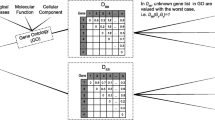Abstract
A central step in the analysis of gene expression data is the identification of groups of genes that exhibit similar expression patterns. Clustering and ordering the genes using gene expression data into homogeneous groups was shown to be useful in functional annotation, tissue classification, regulatory motif identification, and other applications. Although there is a rich literature on gene ordering in hierarchical clustering framework for gene expression analysis, there is no work addressing and evaluating the importance of gene ordering in partitive clustering framework, to the best knowledge of the authors. Outside the framework of hierarchical clustering, different gene ordering algorithms are applied on the whole data set, and the domain of partitive clustering is still unexplored with gene ordering approaches. A new hybrid method is proposed for ordering genes in each of the clusters obtained from partitive clustering solution, using microarry gene expressions. Two existing algorithms for optimally ordering cities in travelling salesman problem (TSP), namely, FRAG_GALK and Concorde, are hybridized individually with self organizing MAP to show the importance of gene ordering in partitive clustering framework. We validated our hybrid approach using yeast and fibroblast data and showed that our approach improves the result quality of partitive clustering solution, by identifying subclusters within big clusters, grouping functionally correlated genes within clusters, minimization of summation of gene expression distances, and the maximization of biological gene ordering using MIPS categorization. Moreover, the new hybrid approach, finds comparable or sometimes superior biological gene order in less computation time than those obtained by optimal leaf ordering in hierarchical clustering solution.
Similar content being viewed by others
Abbreviations
- GA:
-
genetic algorithm
- MIPS:
-
Munich Information for Protein Sequences
- NF:
-
nearest-neighbor
- SOM:
-
self-organizing map
- TSP:
-
traveling salesman problem
References
Applegate D, Bixby R, Chvtal V and Cook W 2003 Concorde Package. [Online], www.tsp.gatech.edu/concorde/downloads/codes/src/co031219.tgz
Bar-Joseph Z, Gifford D K and Jaakkola T S 2001 Fast optimal leaf ordering for hierarchical clustering; Bioinformatics 17 2229
Biedl T, Brejov B, Demaine E D, Hamel A M and Vinar T 2001 Optimal arrangement of leaves in the tree representing hierarchical clustering of gene expression data (Technical report, Department of Computer Science, University of Waterloo)
Eisen M B, Spellman P T, Brown P O and Botstein D 1998 Cluster analysis and display of genome-wide expression patterns; Proc. Natl Acad. Sci., USA 95 14863–14868
Iyer V R, Eisen M B, Ross D T, Schuler G, Moore T, Lee J C F, Trent J M, Staudt L M et al 1999 The transcriptional program in the response of human fibroblasts to serum; Science 283 83–87
Pal S K, Bandyopadhyay S and Ray S S 2006 Evolutionary computation in bioinformatics: A review; IEEE Trans. Systems Man Cybernetics Part C 36 601–615
Ray S S, Bandyopadhyay S and Pal S K 2007 Genetic operators for combinatorial optimization in TSP and microarray gene ordering; Appl. Intelligence 26 183–195
Sharan R, Maron-Katz A and Shamir R 2003 CLICK and EXPANDER: a system for clustering and visualizing gene expression data; Bioinformatics 19 1787–1799
Sherlock G, Hernandez-Boussard T, Kasarskis A, Binkley G, Matese J C, Dwight S S, Kaloper M, Weng S et al 2001 The Stanford microarray database; Nucleic Acids Res. 29 152–155
Tamayo P, Slonim D, Mesirov J, Zhu Q, Kitareewan S, Dmitrovsky E, Lander E S and Golub T R 1999 Interpreting patterns of gene expression with self-organizing maps: Methods and application to hematopoietic differentiation; Proc. Natl. Acad. Sci. USA 96 2907–2912
Tsai H K, Yang J M, Tsai Y F and Kao C Y 2004 An evolutionary approach for gene expression patterns; IEEE Trans. Info. Tech. Biomed. 8 69–78
Venet D 2003 MatArray: a Matlab toolbox for microarray data; Bioinformatics 19 659–660
Author information
Authors and Affiliations
Corresponding author
Rights and permissions
About this article
Cite this article
Ray, S.S., Bandyopadhyay, S. & Pal, S.K. Gene ordering in partitive clustering using microarray expressions. J Biosci 32 (Suppl 1), 1019–1025 (2007). https://doi.org/10.1007/s12038-007-0101-5
Published:
Issue Date:
DOI: https://doi.org/10.1007/s12038-007-0101-5




